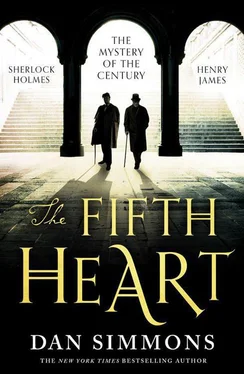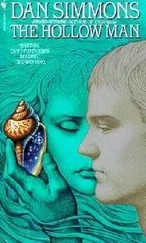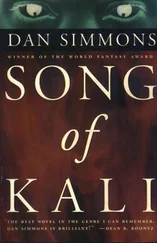Or eat them whole , thought Holmes.
John Hay’s 18-year-old daughter Helen Julia sitting to the Rooseveltcreature’s left was, to Holmes’s always objective eye for such things, one of those rare beautiful female creatures who actually lived up to the image of the new “Gibson Girl”—long, white neck, her hair swept back close to that perfect head until it rolled most naturally into a gay Gibson Girl puff, her soft chiffon dress emphasizing the modern ideal of a woman as tall and slender yet with ample bosom and hips, all while giving off a sense of high intelligence mixed with an athlete’s glow.
Then across the table from Holmes was Henry James, his balding dome seeming to give off an extra beneficial glow in the candlelight. Holmes could see in an instant that James was in his native element, even at an extraordinary table such as this at which sat two senators, a man who was a grandson and great-grandson of Presidents of the United States, several of the wealthiest men in America, no fewer than four famous historians, three of the most beautiful women Holmes had seen in years, and an energetic young cannibal flashing his tombstone-sized teeth.
The Hays obviously had given James the gift of beauty on either side—Helen Julia Hay to his right and Nannie Lodge to his left.
Nannie Lodge sitting between Henry James and John Hay was lovely in the usual Gilded Age ways—slim, fair, wasp-waisted, with lovely hands and a sweet disposition—but the most outstanding aspect of the 43-year-old aging beauty were her eyes . . . eyes which Holmes’s friend Watson would have immediately described as “bewitching” and which Margaret Chanler described in writing as “the color of the sky when stars begin to twinkle.”
No such poetic phrases entered Holmes’s mind on Sunday, April 2, 1893, as he paused a second to study those eyes—Nannie was turned to her left toward John Hay and was not aware of the detective’s brief but intense appraisal—so he filed away the odd, soft intensity of Mrs. Cabot Lodge’s eye color and was reminded of it years later only when his new friend, the painter John Singer Sargent, lamented never having had the chance to paint Nannie Lodge, saying, “I had such an unqualified regard for her that the odds were in favor of my succeeding in getting something of that kindness and intelligence of her expression and the unforgettable blue of her eyes.”
Perhaps.
Beyond Nannie Lodge and the smiling, laughing John Hay, at the corner of the table near Mr. Adams, was the true beauty at the table—Lizzie Cameron.
The doleful-looking Senator Cameron’s wife was, according to Henry James’s whisper as they walked to the Hays’ home that evening, the loveliest and most-sought-after woman in all of Washington society. In his cool, distant way, Sherlock Holmes saw why at once. Lizzie Cameron’s dress was simultaneously the simplest and most daring of any of the perfectly dressed women’s at the table. Her shoulders were bare and white. Her arms were long, perfectly white, and ended in long-fingered hands that looked as though they’d been designed by God to caress men’s faces and hair. She had a long neck unadorned by jewelry or cloth bands and a sharply oval face. Lizzie’s hair this night was gathered up on both sides and rose in a bun in the back but looked impossibly natural.
She did not smile much, Holmes had already noted, and yet with those arching brows, deep, dark eyes, and perfectly shaped mouth, Elizabeth Sherman Cameron was that rarest object of her sex—a woman whose entire beauty could shine through when she was not smiling or even when she looked actively severe.
In the few minutes they’d been seated, Holmes had seen enough of the almost imperceptible glances, nearly invisible reactions to tell him that Henry Adams, at age 55 some 22 years older than Lizzie Cameron, was in love with her; that their host John Hay, without ever looking directly at his table partner to the left, said with his entire body’s balance and tension that he was madly in love with Lizzie Cameron.
Henry James, Holmes could see (and would have predicted), admired Lizzie’s beauty the way a cat might admire a bowl of milk it had no intention of sipping from. Henry Cabot Lodge took his wife’s friend’s beauty as a given of their station in life, young Del Hay had known Lizzie Cameron for most of his life and was obviously looking at her as one of his parents’ friends, and Theodore Roosevelt bestowed his giant, menacing grin upon her with a happily married man’s innocent benevolence. Senator James “Don” Cameron—who would be 60 in two months—looked as miserable as if he’d been actively cuckolded by all the scores and hundreds of men who had dreamt of achieving that blissful goal with the beautiful Lizzie Cameron.
Holmes felt—knew—that Lizzie Cameron teased, teased, tempted, and teased, but did not actually bestow her favors. Not on poor Adams who, Holmes would soon learn, had rushed 10,000 miles around the world from the South Seas to come to Lizzie’s beckoning telegram from Paris only to be shunned by her once he’d arrived. Not on poor John Hay, who—Holmes sensed at once—had yet to declare his physical love for the lady but who, after his inevitable rebuff, would join Henry Adams and a mist-shrouded legion of gray others who had been relegated to the role of “tame cat” in Lizzie Cameron’s life.
And Holmes also felt—knew—that Lizzie Cameron was a dangerous and treacherous person. Certainly, Holmes exempting himself and since neither Professor Moriarty nor Lucan Adler appeared to be present this evening, the most dangerous and treacherous person in the room.
The oysters arrived and the dinner officially began.
A Shocking Shortage of Canvasbacks
While guests had been milling prior to this dinner, Henry James had stepped into the kitchen to say hello to Hay’s chef for this meal, a man named Charles Ranhofer who had served, for a while, as the personal chef for William Waldorf Astor—the richest man in America until he moved to England in 1891. Chef Ranhofer was preparing to publish a cookbook, which ran to more than 1,000 pages, called The Epicurean . It would sell more copies worldwide than any novel Henry James ever published.
James had first met Ranhofer when he was a guest at Lansdowne House, Astor’s rented London mansion, and often heard of the chef’s reputation at Delmonico’s restaurant on Fifth Avenue.
This evening, the famous chef was too busy filling Hay’s oversized kitchen and extended staff with commands, orders, and ultimatums to pause to chat, so James simply wished him well . . . but not before he caught a glimpse of Charles’s menu for the evening—
Menu
________________________
Huîtres en coquille Ruedesheimer
________________________
Potage tortue verte Amontillado
________________________
Caviare sur canapé Médoc
________________________
Homard à la Maryland Royal Charter
________________________
Ris de veau aux champignons
________________________
Selle de mouton
Pommes parisiennes Haricots verts
________________________
Suprème de volaille
________________________
Pâté de foie-gras, Bellevue [Illegible]
________________________
Sorbet à la romaine
Cigarettes
________________________
Teal duck, celery mayonnaise Clos de Vougeot
________________________
Fromage Duque Port Wine
________________________
Читать дальше












